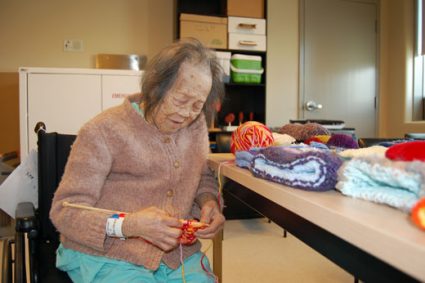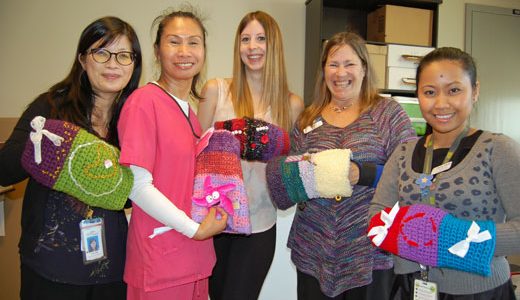Comforting patients with every stitch and purl
The sense of disorientation a patient with dementia experiences can be frightening. A desire to reduce their stress is what motivated Lillian Hung, a VGH clinical nurse specialist (CNS), to choose a PhD dissertation on ways to support people with dementia in acute-care settings.
“We’ve had situations where patients pull out their IV lines and we end up having to tie their hands, which compounds their anxiety,” says Lillian. “I was looking online for alternatives and found a story from the UK where nurses used comfort mitts to distract patients. I thought if it works there, why not here?”
Knitting enthusiasts to the rescue

VGH patient Shui Ping Dang enjoys knitting and is doing her part to grow the supply of comfort mitts for future patients.
Before Lillian could test comfort mitts, she needed to find some. She put the challenge to colleague Alison Lee, patient care coordinator, clinical nurse educator — and knitter — to come up with a prototype for the knitted tube.
“From there we created a poster and used that and social media to ask others to help,” says Lillian. It worked.
Staff, past and present, Langara nursing students and members of the community picked up their knitting needles and volunteered. At 92 years young, Doreen, a retired nurse, is the oldest community volunteer with three comfort mitts to her credit so far.
Welcome distraction for patients

Comfort mitts are accessorized with buttons, ribbons and other items to give patients something to fidget with and relieve anxiety.
Comfort mitts were introduced at VGH during the summer of 2016 and are now in use on hospitalist medicine units with promising results. Made of colourful, textured wool and embellished with accessories like beads and buttons, the mitts provide visual and tactile stimulation while hiding the IV line. Patient feedback has been positive and restraints are needed less often.
“They’re particularly useful for occupying patients who fiddle with and pull at intravenous lines, catheters and oxygen tubing,” explains Lillian. “They also work as wonderful conversation pieces to engage patients at a social level.”
Lillian is unsure how many mitts have been made (patients keep theirs when discharged), but she’s grateful to everyone for their assistance, notably Gail Peake, activity worker, who has made numerous versions.
“Everyone brings their own creative elements,” says Lillian, referring to a table of mitts in a rainbow of colours. “Thanks to our volunteers, comfort mitts have helped to improve the patient experience.”
Learn more at Quality Forum 2017
Lillian, Alison and Jenifer Tabamo, VGH CNS, are scheduled to present their early findings and discuss the potential for using comfort mitts in other settings, including residential and community care, at Quality Forum 2017 on March 2. Can’t attend the forum? You can access their presentation here.
Related stories
Can iPads comfort patients with dementia?
What the person behind the illness teaches us (recorded webcast with Jenifer Tabamo, CNS, on “This is Me” initiative)


Jillian Robertson
I would like to help by knitting a few mittens does anyone have a pattern?
Lillian Hung
Instructions
This mitt pattern is perfect for using up leftover and odd balls of wool.
Needles: 8 mm circular or 6.5 mm straight needles. Have FUN
Cast on 45 stitches using two strands of double knitting wool or 1 strand of chunky wool (one
plain color works best). Work in stocking stitch (knit a row, purl a row) for 11 inches.
Continue with stocking stitch, but use up oddments of various textures of wool such as
chunky, mohair, ribbon, etc. until the work measures 23 inches (two strands of double knit
for two rows each gives a lovely assortment of colors).
To finish: If working with straight needles, lightly iron the long strip, then neatly join the
sides together using the edge to edge stitch (with the knit side facing out). Turn inside out and
push the one-colour cuff up inside the mitt body. Sew the two ends together, again using a
neat edge-to-edge stitch.